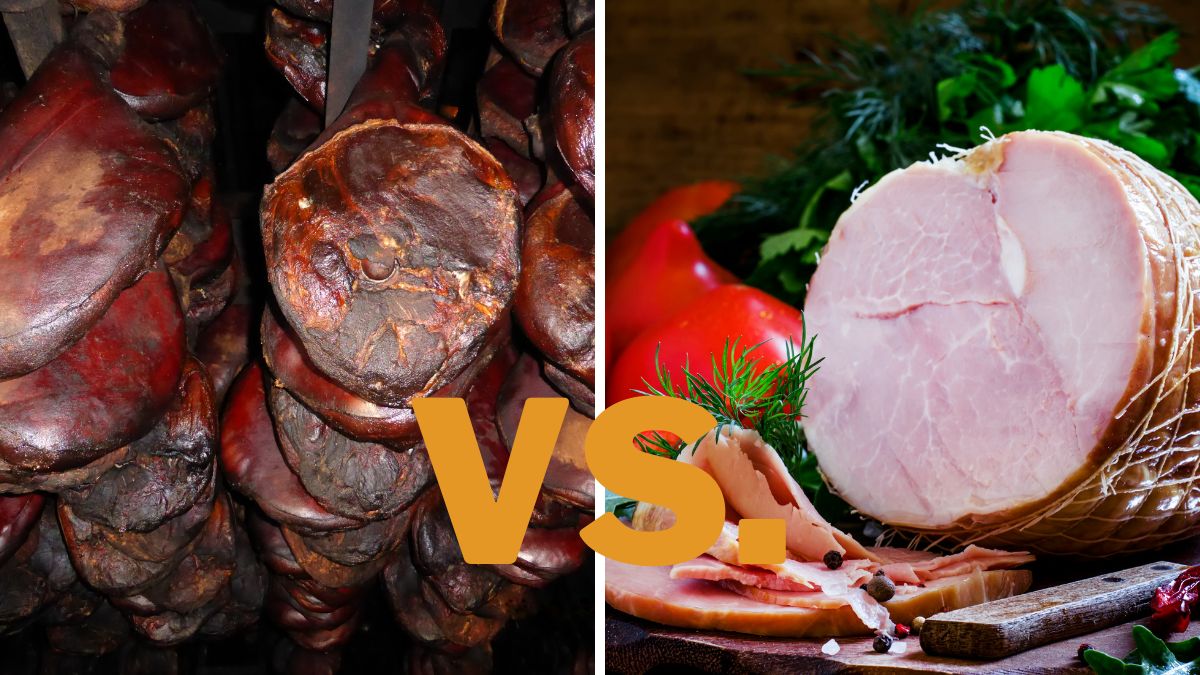Cured Ham vs. Uncured Ham: Differences & Which is Better?

During holidays time, ham becomes an inevitable part of everyone’s table. Aromatized ham is a holiday tradition. You will want to impress your guests, but there are so many varieties you don’t know where to start. So, what are the differences between cured and uncured ham, and which is better?
Uncured ham has a lighter flavor than cured ham since it isn’t smoked. Cured ham contains artificial compounds, while uncured ham uses only natural sources of nitrites. Chemically or naturally boosted, the goal is the same – to have a safe-to-eat ham.
To eat mindfully and enjoy every bite of food, you need to know your meat. There is a reason why the ham takes a central place at your table. Keep reading to discover everything about your favorite holiday dish.
What is Cured Ham?
Cured ham is a term used for chemically processed meat. Chemical curing represents the usage of nitrites, nitrates, ascorbate, or phosphates. Those, in fact, aren’t necessarily bad things.
This ham is all over the shelves in supermarkets. It has a long shelf life, and it doesn’t have to be refrigerated. Smoky cured ham is among everyone’s favorite snacks for its tangy taste.
What is Uncured Ham?
Uncured ham is also cured but without chemicals. With some help of salt, celery, and seasoning to avoid chemicals, the ham will be safe for consumption.
Uncured ham carries the label of organic food, due to the fact curing occurs with natural ingredients. It can taste a little bland because herbs used for seasoning don’t have a pungent taste.
Cured Ham vs. Uncured ham: Differences
Both varieties come from the same cut of meat. If it’s the same cut, are there any differences? In fact, yes, differences reflect in preparation and additives.
Preparation: Process, Ingredients, and Safety
Chemical curing used for cured ham is faster than natural. Sodium nitrite, sodium acetates, sodium diacetate, and sodium erythorbate are all chemicals that boost the process. Brine consists of those chemicals, salt, sugar, and flavors.
Sodium nitrite or nitrite salt is the most controversial among these compounds. It quickens curing, has antimicrobial effects, and acts like a coloring agent. The signature deep red or pinkish color of ham comes from sodium nitrate.
Sodium nitrite prevents reactions that induce meat spoilage. In other words, it keeps its aroma and flavor for a long time.
Another key role is antimicrobial. [1] Nitrites avert bacterial contamination of the meat.
When looking for uncured ham, look for labels that say “no nitrites added” or “synthetic preservatives free.” Is it really true that uncured ham is free of nitrites? Of course not. The only thing different is the source of those nitrites.
Celery, spinach, and beets are natural sources of nitrites. [2] When curing meat, people usually use celery powder or juice. Celery doesn’t have an impact on the color of the ham and gives it a slight taste.
Even from natural ingredients, sodium nitrate is still sodium nitrate. [3] One more surprising thing is that celery in uncured meat doesn’t have to be grown organically.
Salt helps in dehydration which leads to the destruction of most of the pathogens, as it’s left without fertile ground. Sea salt is usually an option for uncured meat, and pink curing salt is for cured meat. That salt is rich in added nitrites, that’s the reason for the pink color.

Taste
Cured ham is both sweetened and salted at the same time, which makes it so compelling. It has a smoky flavor due to its specific curing process.
Sugar prevents the coarseness of salt. Plus, it’s food for bacteria that produce specific flavors during cooking. Because of the presence of sugar, ham doesn’t leave a harsh aftertaste.
Uncured ham doesn’t have the strong flavor as cured. That’s because it isn’t smoked, only cured in natural ingredients. Natural seasoning has a more delicate flavor, and ham is never too salty.
Cured ham is usually drier because both salting and smoking withdraw water. Artificial flavorings are injected directly into the ham, so it has a deeper savor. If you want to emphasize the flavors of uncured ham, glaze it with honey or maple syrup. It will make the existing saltiness pop.
Serving
Both cured and uncured ham go well with roasted vegetables. The classic of a holiday table, along with ham, are mashed potatoes. Plus, you can be ingenious when speaking of potatoes as a side dish.
They make a mouth-watering base for a crunchy baguette sandwich. Add fresh veggies: tomato, onion, and arugula for a pinch of bitterness.
If you want something fancier, wrap melon slices with prosciutto. Melon will emphasize its salty flavor. If you like the sweet and salty combo, try honey-glazed ham. Coat your ham in honey and bake till golden crisp.
Appearance
As said before, cured ham has a deep-red or pink color. Let’s explain the path of getting that appealing color. [4]
When injected into the meat, sodium nitrite transfers to nitric oxide. Nitric oxide then bonds with myoglobin (a dark red protein found in muscles). The next step is the synthesis of nitrosylmyoglobin. After heating, it transfers to nitrosohemochrome – the pink pigment.
Research showed that nitrites from celery react the same way with myoglobin. [5] But vitamin C causes slight discoloration of uncured ham. In the end, it has a little bit darker and yellowish shade, which is entirely normal.
Nutrition
1 oz of cured ham has about 15 calories more than uncured ham. [6] Values of macronutrients are pretty much the same, with a few grams of difference. They are both satisfactory sources of protein, about 6 grams per oz.
Uncured ham, in fact, has more fat, but it can differ regarding how lean the meat is. [7] If you remember that both sorts of ham require lots of salt, you aren’t surprised by the high amounts of sodium.
Be aware that 1 oz of cured ham has more than 270 milligrams, and cured ham has 220 milligrams of sodium. If you’re on a low-sodium diet, consider avoiding daily consumption.
Cured Ham vs. Uncured Ham: Which is Better?
Processed meat, whether chemically or naturally, is still processed meat. The best thing you can do for yourself is to consume it moderately.
Both ham varieties have similar macronutrients and high amounts of nitrates. Another key thing to remember is that celery powder doesn’t have limits in its use. Products like that carry “nitrite-free” labels.
Those kinds of information are inaccurate and misleading. Not to mention that uncured ham often has a higher concentration of nitrites due to the fact natural nitrites don’t have to be tracked.
In the end, it all comes down to your individual preference. Whether you like the smoky, rich taste of cured or milder smack of uncured ham.
